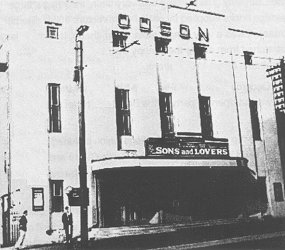





 |
While the Savoy was being built, ABC loaned the cinema facilities at the
new Theatre Royal. The Savoy was a very plain
building with very little external decoration but masses of brickwork.
However, the finished building was very geometrically pleasing. It took
up the whole of the corner of Garrick Street and Bilston Street and
stretched from that corner, around the next corner into Old Hall Street.
The new cinema boasted a very large circle (upstairs) with seating for
over 600 patrons and a large stalls (downstairs) which could accommodate
nearly 1200 people. While the auditorium was not as elaborate as the
Gaumont or Odeon, it was still an outstanding building. It was the last
of the town centre super cinemas. Three more large
cinemas were built in the suburbs of the town during the 1930's. The
first of those cinemas was the Dunstall
which was built on the Stafford Road, near Dunstall Park Racecourse
and across the road from the then existing ECC factory and the road to
Bushbury. The original site is now opposite the large island/roundabout
on that section of the Stafford Road.
The Dunstall was the brain-child of four men, Jack Roper, John
Tyler, Dr. Hamp and
R.E. Probert (a future Mayor of the town). The design was
apparently based on the Dale
cinema in Willenhall and Wood's Palace in Bilston.

The Odeon Cinema, Dunstall. |
It could accommodate 1400 patrons. It had
quite an impressive white frontage, with steps leading up to four
doors. There was a large canopy over the entrance. It had a large
auditorium and an enormous screen which was set back 10 yards from
the front row of the stalls. It had a very large stage which was
designed for live entertainment. The opening took place on November
19th 1934 and was attended by Winifred Shotter, one of the stars of
the first film shown 'Lilies of the Field'. By 1936
the cinema had been taken over by the Odeon circuit and was known as
the Dunstall Odeon or Odeon Dunstall. |
| The second of the suburban cinemas was the
Penn which was built on Warstones Road, opposite the bottom of
Pinfold Lane, the site of the current Somerfield
Supermarket. It was built by the Penn Cinema Company. The
building was very plain, involving a large amount of brick work (Baggeridge
bricks supplied by one of the directors of the cinema company,
Tommy Whitehouse). |

Penn Cinema.
|
It was a very simple rectangular shape. It had
five large windows at the front which stretched from above the canopy
over the entrance to the balcony foyer. It could accommodate about 1100
patrons. The Penn officially opened on December 27th 1937 with the film
'Day at the Races' starring the Marx Bros. There was an opening
party at the Bradmore Hotel after the film show. The Penn was quite
renown during the war for its fortifications which included sandbags
across the front entrance. It was used as a base by both the Home Guard
and ARP. The cinema continued operating throughout the war, including
matinee performances for the children.
The last of the cinemas to open in the town before the war was the
Clifton at Fallings Park, an area of the town which lies off the
Cannock Road. The cinema was built on the junction of the Cannock Road
and Raynor Road (the current site of another Somerfield
Supermarket). The cinema stood well back from the corner and
involved a largely brick frontage with two towers on either side of the
entrance. The entrance was reached by a set of steps up to three sets of
doors. It had three long vertical windows which rose above the canopy
over the entrance and reached the upper foyer. It is interesting to note
that the building had no other windows.
The Clifton opened on October 24th 1938. The first film shown
was 'Happy Landing'. It could accommodate 1100
patrons and was fortunate to have a large local audience, especially
from the Low Hill estate. As a result the cinema was very successful
during the war.
Wednesfield had its own super cinema which opened on October 14th
1935. It was the Regal.
It stood on the corner of the High Street, opposite the village
church of St. Thomas. Although it was part of the Clifton circuit it was
called the Regal. The cinema could accommodate over 1000 people but it
appeared a much larger building than its accommodation figures imply.
Like many other cinemas of the time, it seemed to have masses of
brickwork and few windows. It had two sets of doors and a canopy over
the entrance with the legend Wednesfield's Wonder Cinema. The
first programme of films at the Regal was a varied selection with
'Bulldog Jack' starring Jack Hulbert and Fay Wray, a
supporting film, a cartoon, news and two silent films made in the early
years of the century. The Regal proved to be an immense success and was
extremely popular with the local population who showed loyalty to their
own cinema. It hosted a number of interesting and successful stage
productions during World War 11. In Bilston no new cinemas were built
during the 1930's, although there were obviously a number of
changes made to the town's existing cinemas and the talkies arrived in
the town, as they did everywhere else.
 |
|
 |
Next
Page |
|
Contents |
|
|






 |

















